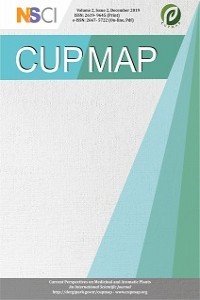Antimicrobial Activity of Different Flower Extracts
Antimicrobial Activity of Different Flower Extracts
. Flowers, Methanolic extract, Disc Difussion method,
___
- Ammar I. Ennouri m. Khemakhem B. Yangui T. Attia H. 2012. Variation in chemical composition and biological activities of two species of Opuntia flowers at four stages of flowering. Industrial Crops and Products 37 (2012) 34– 40
- Arslan M. Erbil N. Murathan Z.T. 2018. Ardahan ve Çevresinde Yabani Olarak Yetişen Gilaburu Meyve Ekstraktının Antimikrobiyal, Antioksidan ve Antimutajenik Aktivitelerinin Araştırılması, GÜFBED/GUSTIJ (2018) 8 (1): 18-25
- Bourgaud F. Gravot A. Milesi S. Gontier E. 2001. Production of plant secondary metabolites: a historical perspective. Plant science 161, 839-851.
- Česoniene, L., Daubaras, R., Kraujalyte, V., Venskutonis, P.R. and Šarkinas, A., 2014. Antimicrobial activity of Viburnum opulus fruit juices and extracts, Journal fur Verbraucherschutz und Lebensmittelsicherheit, 9, 2, 129-132
- Dahham S.S. Naiman-Ali M. Tabassum H. Khan M. 2010. Studies on Antibacterial and Antifungal Activity of Pomegranate (Punica granatum L.) American-Eurasian J. Agric. & Environ. Sci., 9 (3): 273-281, 2010
- Dülger B. Gönüz A. 2004. Antimicrobial Activity of certain Plants used in Turkşsh Traditional medicine. Asian Journal of plant Sciences3(1): 104-107
- Eroğlu-Özkan E. Demirci-Kayıran S. Toplan-Gülsoy G. Mataracı-Kara E. Kürkcüoğlu M. 2018. Identıfıcatıon Of Volatıle Compounds And Antımıcrobıal Actıvıtıes Of Muscarı neglectum Growıng In Turkey. Fresenius Environmental Bulletin 21:7 4674-4678
- Ghaima-Kassim K. Hashim Makie N. Abdarlrasool-Ali S. 2013 Antibacterial and antioxidant activities of ethyl acetate extract of nettle (Urtica dioica) and dandelion (Taraxacum officinale). Journal of Applied Pharmaceutical Science Vol. 3 (05), pp. 096-099,
- Hızlısoy, H., 2009. Çeşitli mikroorganizmalar üzerine gilaburunun antimikrobiyal etkisinin incelenmesi. Erciyes Üniversitesi, Sağlık Bilimleri Enstitüsü, Yüksek Lisans Tezi
- Hsu W.Y. Simonne A. Weşssman A. Kim J.M. 2010. Antimicrobial Activity of Greater Galangal [Alpinia galanga (Linn.) Swartz.] Flowers. Food Sci. Biotechnol. 19(4): 873-880 (2010)
- Jeeva S. Johnson M. Aparna J.S. Irudayaraj V. 2011. Preliminary Phytochemical and Anti-Bacterial studies on Flowers of selected medicinal plants. Int. J. Med. Arom. Plants, Vol. 1, No. 2, pp. 107-114.
- Lazarevic, J.S. Dordevic, A.S., Zlatkovic, B.K., Radulovic, S.N., Palic, R.M. 2010. Chemical composition and antioxidant and antimicrobial activities of essential oil of Allium sphaerocephalon L. subsp. sphaerocephalon (Liliaceae) inflorescences. J Sci Food Agric; 91: 322–329.ahboubi A. Asgarpanah J. Sadaghiyani P.N. Faizi M. Total phenolic and flavonoid content and antibacterial activity of Punica granatum L. var. pleniflora flowers (Golnar) against bacterial strains causing foodborne diseases. BMC Complementary and Alternative Medicine 15:366lcek J. Rop O. 2011. Fresh edible flowers of ornamental plants- A new source of nutraceutical foods. Trends in Food Science & Technology 22 (2011) 561-569.
- Pavithra G.M. Saba S. Abhishktha S.N. Prashith K.T.R. Vinayaka K.S. 2013. Antioxidant and antimicrobial activity of flowers of Wendlandia thyrsoidea, Olea dioica, Lagerstroemia speciosa and Bombax malabaricum. Journal of Applied Pharmaceutical Science Vol. 3 (06), pp. 114-120
- Rojas R. Bustamante b. Bauer J. Fernandez I. Alban J. Lock O. 2003. Antimicrobial activity of selected Peruvian medicinal plants. Journal of Ethnopharmacology 88, 199–204
- Sajjadi S.T. Saboora A. Mohammadi P. 2016. Comparison of aglycon and glycosidic saponin extracts of Cyclamen coum tuber against Candida spp. Curr Med Mycol, 2016 Jun, 2(2): 40-44
- Saratale G.R. Benelli G. Kumar G. Kim Su D.2018. Bio-fabrication of silver nanoparticles using the leaf extract of an ancient herbal medicine, dandelion (Taraxacum officinale),evaluation of their antioxidant, anticancer potential, and antimicrobial activity against phytopathogens. Environ Sci Pollut Res (2018) 25:10392–10406.
- Sharifi-Rad J. Sureda A. Tenore G.C. Daglia M. Sharifi-Rad M. et al. 2017. Biological Activities of essental oils: From Plant chemoecology tı Traditional Healing Systems. Molecules, 22, 70;
- Sharma A. Flores-Vallejo R.C. Cardoso-Taketa A. Villarreal M.L. 2017. Antibacterial activities of medicinal plants used in Mexican traditional medicine. Journal of Ethnopharmacology. 208(2017)264–329
- Tunç K. Konca T. Hoş A. 2013. Punica granatum Linn. (nar) bitkisinin antibakteriyel etkisinin araştırılması. SAÜ. Fen Bil. Der. 17. Cilt, 2. Sayı, s. 167-172,
- Türker A.U. Usta C. Biological screening of some Turkish medicinal plant extracts for antimicrobial and toxicity activities. Natural Product Research, Vol. 22, No. 2, 20 January 2008, 136–146
- Usta C. Birinci-Yıldırım A. Uçar-Türker A. 2014. Antibacterial and antitumour activities of some plant grown in Turkey. Biotechnology & Biotechnological Equipment, Vol. 28, No. 2, 306-315,
- Verpoorte R. Contin A. Memelink J. 2002. Biotechnology for the production of plant secondary metabolites. Phytochemistry Rewiews 1: 13-25.
- Xianfei X. Xiaoqiang C. Shunying Z. Guolin Z. 2007. Chemical composition and antimicrobial activity of essential oils of Chaenomeles speciosa from China. Food Chemistry 100 (2007) 1312–1315
- ISSN: 2619-9645
- Yayın Aralığı: Yılda 2 Sayı
- Başlangıç: 2018
- Yayıncı: Nazım ŞEKEROĞLU
Jaya ARORA, Bhanupriya KANTHALIYA, Abhishek JOSHI
Violeta DİMİTROVA, Alexander TASHEV
Ethnopharmacological Survey on Phlomis grandiflora: in vivo Antihemorrhoidal Model
Ceylan DÖNMEZ, Ufuk KOCA ÇALIŞKAN
Višnja OREŠČANİN, štefica FİNDRİ GUŠTEK
Rüveyde TUNÇTÜRK, Murat TUNÇTÜRK, Lütfi NOHUTCU
Antimicrobial Activity of Different Flower Extracts
Kenan TUNÇ, Alican Bahadır SEMERCİ, Dilek İNCEÇAYIR, Mehmet Sağıroğlu SAĞIROĞLU
